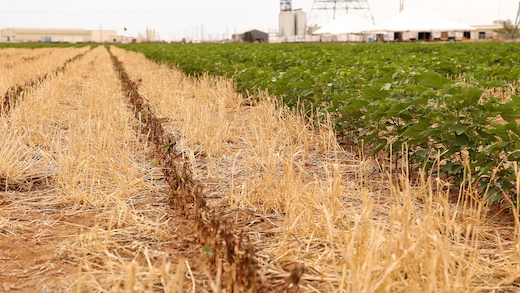FIGHTING WEEDS IN WEST TEXAS
To help producers better control weeds in West Texas, PhytoGen held field days at the Southwest Experience Center in Lubbock, Texas, to showcase the effectiveness of the Enlist® weed control system.
To help producers better control weeds in West Texas, PhytoGen held field days at the Southwest Experience Center in Lubbock, Texas, to showcase the effectiveness of the Enlist® weed control system.
For West Texas cotton growers, yield-robbing weeds are as relentless as the wind.
To help producers better control weeds in the windiest part of the Cotton Belt, PhytoGen held field days at the Southwest Experience Center in Lubbock, Texas, last summer and showcased the effectiveness of the Enlist® weed control system under real-world conditions.
As PhytoGen® cottonseed continues to grow in Texas — with the No. 1 most-planted variety for two years in a row1 — producers are looking for information to help them manage newer varieties and control weeds with the Enlist weed control system.
“Our goal was to help West Texas producers see all the benefits that PhytoGen W3FE varieties and the Enlist weed control system bring to the table,” said Ken Legé, Ph.D., PhytoGen cotton development specialist. “Not only do growers get high yield potential, but also they can confidently make on-target applications of Enlist herbicides for superior weed control.”

Enlist One® and Enlist Duo® herbicides utilize a formulation of 2,4-D choline with Colex-D® technology for near-zero volatility and reduced drift potential, when applied according to label instructions.
“The difference with Enlist herbicides is 2,4-D choline,” Legé said. “It’s not an amine. It’s not an ester. It’s a totally different molecule that’s designed to land and stay where it’s sprayed.”
One of the demonstrations at the Southwest Experience Center showcased the near-zero volatility of Enlist herbicides, even under extreme conditions. On a hot mid-August afternoon, Legé poured 32 ounces of Enlist One herbicide into a glass dish and placed it under the canopy of susceptible cotton. He removed the dish 24 hours later. After two weeks of observation, the team found no signs of volatilization – the cotton plants surrounding the dish were not damaged.
“If Enlist One herbicide had volatilized at all, we would have smoked the plants around that glass dish,” Legé said. “We did not see any 2,4-D symptomology, neither on the plants hanging over the solution or in the surrounding area.”
The PhytoGen team also wanted to show West Texas growers the reduced physical drift they can expect with Enlist herbicides by following labeled application requirements. By following label requirements, growers can mitigate physical drift substantially compared with applications of traditional 2,4-D. For example, using qualified nozzles with Enlist Duo herbicide reduces the potential for physical drift by 90% compared with a tank mix of traditional 2,4-D and glyphosate.
Scott Fuchs, PhytoGen cotton development specialist, recommends growers use a checklist for properly applying Enlist herbicides that includes: knowing what your neighbors are planting, understanding wind speed and direction, setting appropriate boom height, using the correct spray nozzles and pressure, and avoiding application during a temperature inversion.
“Keeping these things in mind, West Texas producers can successfully apply Enlist herbicides with reduced physical drift and near-zero volatility,” Fuchs said.
Following the same checklist and all label requirements, the PhytoGen team conducted an application demonstration in which Enlist One herbicide was applied over 36 rows of susceptible cotton, referred to as the “application zone.” To truly test the physical drift, the sprayer ran at 15 mph with the nozzle pressure set to 64 psi. While on label, these parameters are well above what most growers would typically use during herbicide applications.
The team checked the field two weeks later to assess the level of physical drift and volatility.
“When we went to make our observations, the demonstration confirmed that Enlist One herbicide reached the target and stayed where it was sprayed,” Legé said. “In the second row upwind of the application, there was no sign of damage to the susceptible cotton, and we had winds from every direction in the 72 hours following the application. This indicated that the solution did not volatilize.

PhytoGen Cotton Development Specialist Ken Legé, Ph.D., said the team sprayed Enlist One® herbicide over susceptible cotton to show that it did not volatilize or drift upwind, as shown by this photo of the rows immediately upwind of the application site.
“The application worked just as we expected. Even in West Texas, the windiest place in the Cotton Belt, you can successfully apply Enlist herbicides. We’re excited to give West Texas producers more tools to manage weeds, along with proven yield benefits of PhytoGen cottonseed.”
Before spraying Enlist® herbicides, review this checklist to help ensure your application is on-target, effective and successful.
Find information on yield and more in the PhytoGen Cottonseed Agronomy Library.